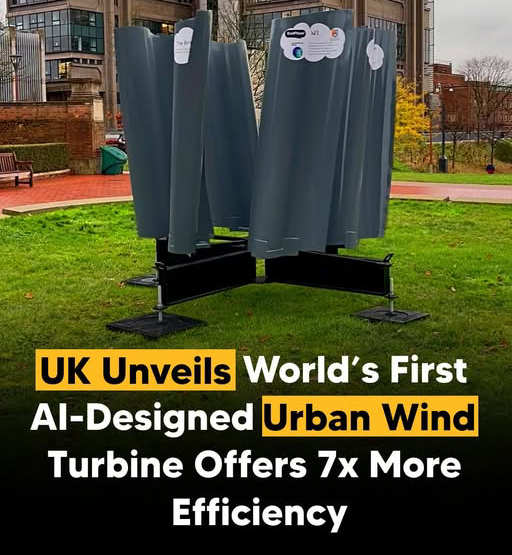UK Unveils World's First AI-Designed Urban Wind Turbine, the Birmingham Blade

The UK has shown the first AI-designed urban wind turbine, called the Birmingham Blade, in an amazing advance step for renewable energy. Designed especially to flourish in the low wind speeds usually found in urban settings, such Birmingham, where the average wind speed is only roughly 3.6 meters per second—well below the 10 meters per second most conventional wind turbines are built to handle.
The Birmingham Blade results from a partnership between metal fabricators KwikFab and artificial intelligence design company EvoPhase. This research aims to produce a wind turbine far more efficient in urban settings, where slower and more erratic wind speeds are found. Although conventional wind turbines may struggle in certain environments, the Birmingham Blade has been especially made to function when other turbines could fail.
The artificial intelligence used in this wind turbine makes it really special. The design firm working on the project, EvoPhase, developed and tested several prototypes using AI simulations. By means of this procedure, they were able to maximise the form and structure of the blade therefore enabling its significantly more low-wind efficiency. The results are very remarkable: the Birmingham Blade is up to seven times more efficient than conventional wind turbines in perfect urban settings.
By considering several elements including wind patterns, turbulence, and environmental variables, EvoPhase's AI technology helped the team create a design that maximises energy output even in areas where wind is less dependable. This is a major paradigm change in our understanding of renewable energy, particularly for towns sometimes unable to implement conventional wind power solutions.
KwikFab, a metal manufacturing business renowned for accuracy, has already constructed the first Birmingham Blade prototype. This prototype will be tested under real-world settings on rooftops in Birmingham, where it is set to be These tests should yield useful information that will enable further design refinement by means of data. Should all proceed according to strategy, the Birmingham Blade's final form should be ready by late 2025.
The way urban energy generation is produced going forward may be much changed by this evolution. Finding solutions to create sustainable energy within metropolitan settings is becoming more crucial as cities keep expanding and get more packed. Because of the difficulties with low wind speeds, wind energy has sometimes been considered as unworkable in city environments; yet, the Birmingham Blade might alter everything.
Apart from its efficiency, the urban wind turbine is supposed to assist lower city carbon footprint. Creating renewable energy from the wind might help towns reach their sustainability goals and aid to lower dependency on fossil fuels. The success of the Birmingham Blade may open the door to a whole new wave of AI-driven, city-friendly wind turbines as more and more communities all around search for cleaner energy alternatives.
Looking ahead, the Birmingham Blade stands for the kind of creativity that might redefine our perspective on municipal renewable energy. Its use of artificial intelligence and emphasis on urban adaptation point to the still great possibilities for wind power in areas where it was once considered to be unworkable. Should the prototype testing go well, we may see more artificial intelligence-designed turbines dotting rooftops and metropolitan areas worldwide, therefore enabling sustainable city power from these sources.
Though its journey is only just beginning, the Birmingham Blade has unquestionably the ability to change the way urban energy generation is produced. Watch this fascinating initiative as it develops and is ready to transform city generation of sustainable, renewable energy.
--
